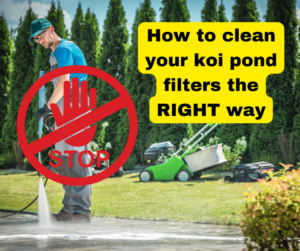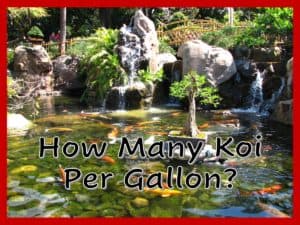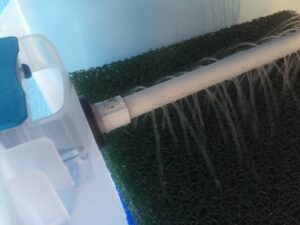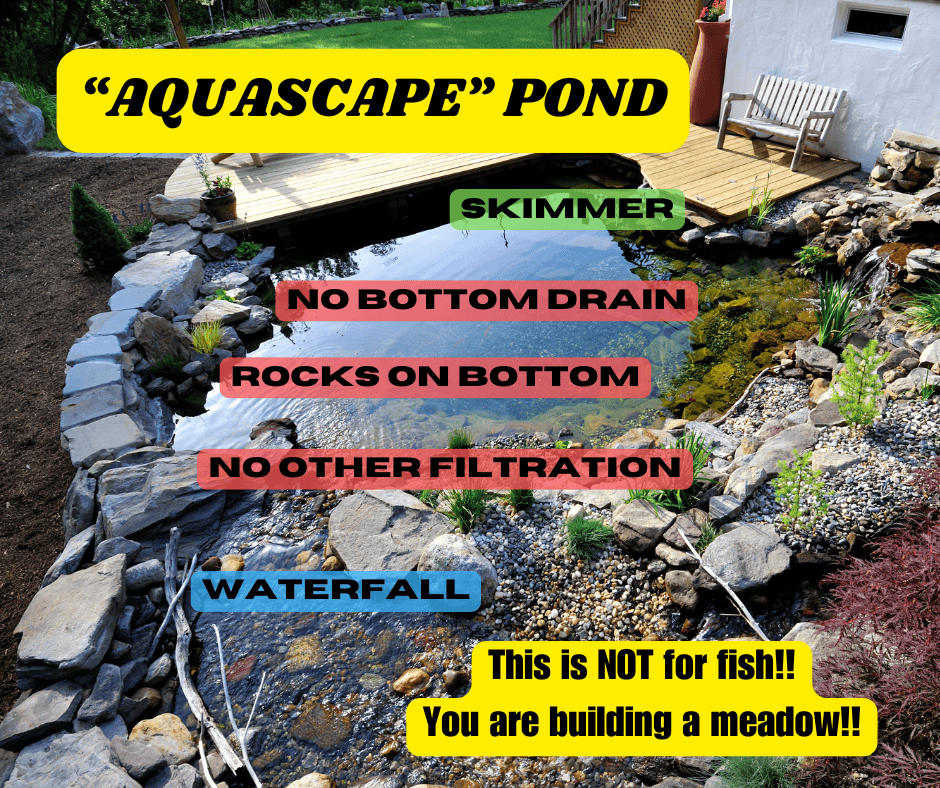When it comes to cleaning koi pond filters, there is a right way and wrong way to do the job. If you do not clean your koi pond filters correctly, you could be severely damaging your fish’s environment. Learn how to clean you koi pond filters the RIGHT WAY and your fish will thank you!
Looking to clean your fish tank? Learn how to here!
Why are koi pond filters important?
Koi pond filters have many jobs. The key point is that they keep your water clean, so you can see your fish, and healthy for your fish to breathe. Different koi pond filtration components can be broken into a few main types of jobs:
- Mechanical Filtration – removing debris from the water (ex. skimmer, mesh, floss)
- Biological Filtration – performing your pond’s nitrogen cycle (ex. beads, sand, strapping)
- Chemical Filtration – altering the chemical make up of your tater (ex. UV sterilizer, carbon)
Learn more about koi pond filtration in our Koi Pond Filters post.

Most koi pond filters are graded per the total volume of WATER in your pond. They do NOT consider how many fish you have, how big they are and how much/what they are eating! Just because your filtration is rated for your pond size, it may not be enough. Always test your water chemistry regularly to ensure your fish have enough room. Do you know how much room one koi or one goldfish require all to themselves? If your water chemistry, particularly your ammonia and nitrite levels, cannot come within range, this is a clear indication that you may require additional filtration components to keep your fish happy and healthy.

Why does it matter how I clean my koi pond filters?
Most of the time, when we discuss filtration cleaning with our clients, they are either doing too much or too little, and it depends on what type of filtration they use. There is no “one-size-fits-all” solution to filtration in koi ponds, so if you are having issues with any of your current components, it’s time to consult a professional about some upgrades and improvements.
Here are the most common issues with cleaning koi pond filters:
Overcleaning Koi Pond Mat Filters
Koi pond filter mats, such as Matala, come in a variety of sizes and densities. They are typically used for both mechanical and biological filtration. The biggest issue when cleaning koi pond filter mats is the temptation to lay them on the driveway and blast them pristinely clean with your pressure washer or hose. This removes most of the good bacteria you have worked so hard to grow, stunting your biological filtration and causing a secondary ammonia spike.
Correct cleaning method –> remove them, shake them, tap them on a solid surface if you like, and then put them back. They will not be 100% clean, but that is the point! You just want water to be able to run through them easily.

Under Backwashing Pressurized Bead Filters
Bead filters are the most common type of koi pond filter, again combing mechanical and biological filtration. However, since it is all contained within an opaque sphere, it is hard to know the state of your filter media. One of the biggest limitations of bead filters is oxygen capacity. The process of nitrification that runs your biological filtration requires lots of oxygen, and depending on how your system is plumbed, your filter may have more dying bacteria than functioning ones, leading to excess debris.
Correct cleaning method –> backwash once a week at least for 5-10 minutes. The longer you wait between backwashes, the more time debris has to settle and clog. Utilize a blower to allow for maximum cleaning capability. Learn how to correctly backwash with Rick Blazo of Blazo Pond Services
Ignoring Waterfall Filters
Matting, bags or strapping at the top of your waterfall and/or in your skimmer (if you have an “Aquascape” pond, please pay attention) can easily get clogged, especially if the waterfall is tucked away. Many of these ponds in our service fall victim to clogs that essentially move water around your filter, not through it. This can cause your filtration to stall out and increase your ammonia and nitrite levels since they can’t reach the bacteria to move them along the nitrogen cycle. (I know the “rules” say to clean it once or twice a year, but this is not sufficient for most ponds.)
Correct cleaning method –> At least once a week, just check your filters. Water should be flowing through the middle, NOT around the edges. If you cannot see your filters, it’s time for a cleaning. Rinse them in a bucket of pond water or shake them thoroughly. No hose!

We know there are a lot of fun things to enjoy about your pond, but it’s more than just a hole in the ground. Taking good care of your fishes’ filtration will go a long way to ensure their overall health and wellbeing.

